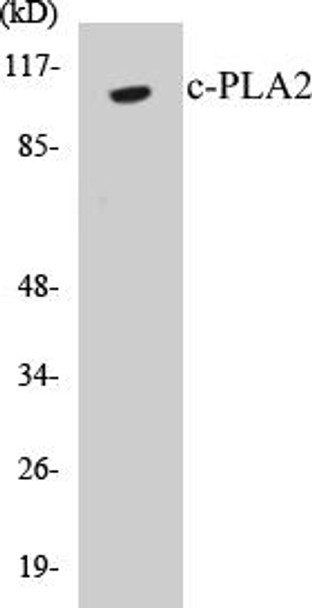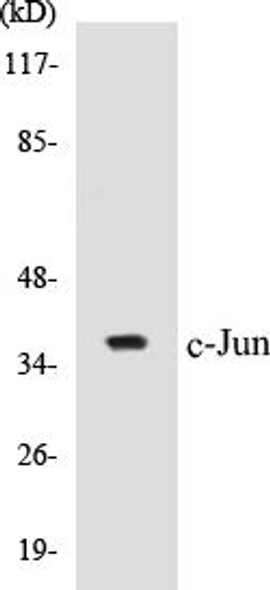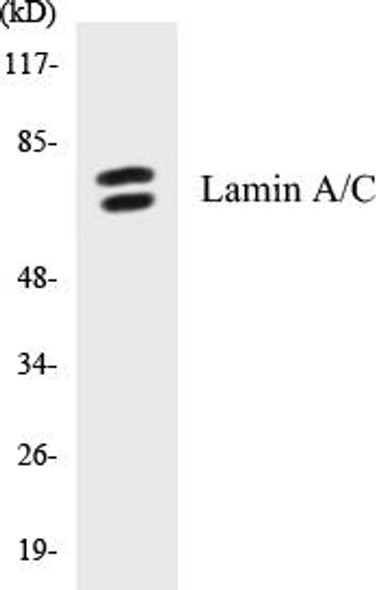Metabolism
c-PLA2 Colorimetric Cell-Based ELISA Kit
- SKU:
- CBCAB00597
- Product Type:
- ELISA Kit
- ELISA Type:
- Cell Based
- Research Area:
- Metabolism
- Reactivity:
- Human
- Reactivity:
- Mouse
- Reactivity:
- Rat
- Detection Method:
- Colorimetric
Description
| Product Name: | c-PLA2 Colorimetric Cell-Based ELISA |
| Product Code: | CBCAB00597 |
| ELISA Type: | Cell-Based |
| Target: | c-PLA2 |
| Reactivity: | Human, Mouse, Rat |
| Dynamic Range: | > 5000 Cells |
| Detection Method: | Colorimetric 450 nmStorage/Stability:4°C/6 Months |
| Format: | 96-Well Microplate |
The c-PLA2 Colorimetric Cell-Based ELISA Kit is a convenient, lysate-free, high throughput and sensitive assay kit that can detect c-PLA2 protein expression profile in cells. The kit can be used for measuring the relative amounts of c-PLA2 in cultured cells as well as screening for the effects that various treatments, inhibitors (ie siRNA or chemicals), or activators have on c-PLA2.
Qualitative determination of c-PLA2 concentration is achieved by an indirect ELISA format. In essence, c-PLA2 is captured by c-PLA2-specific primary antibodies while the HRP-conjugated secondary antibodies bind the Fc region of the primary antibody. Through this binding, the HRP enzyme conjugated to the secondary antibody can catalyze a colorimetric reaction upon substrate addition. Due to the qualitative nature of the Cell-Based ELISA, multiple normalization methods are needed:
| 1. | A monoclonal antibody specific for human GAPDH is included to serve as an internal positive control in normalizing the target absorbance values. |
| 2. | Following the colorimetric measurement of HRP activity via substrate addition, the Crystal Violet whole-cell staining method may be used to determine cell density. After staining, the results can be analysed by normalizing the absorbance values to cell amounts, by which the plating difference can be adjusted. |
| Database Information: | Gene ID: 5321, UniProt ID: P47712, OMIM: 600522, Unigene: Hs.497200 |
| Gene Symbol: | PLA2G4A |
| Sub Type: | None |
| UniProt Protein Function: | cPLA2: a calcium-dependent phospholipase A2 that catalyzes the release of arachidonic acid from membrane phospholipids. Selectively hydrolyzes arachidonyl phospholipids in the sn-2 position releasing arachidonic acid. Arachidonic acid is a precursor for the eicosanoids that are involved in hemodynamic regulation, inflammatory responses, and other cellular processes. Promotes cerebellar long-term depression and motor learning. Translocates to the Golgi and endoplasmic reticulum in a calcium-dependent fashion. Translocation and activation of at the ER facilitates the process of ER stress. Regulates the biogenesis of lipid droplets, a process dependent on JNK and ceramide kinase. Stimulated by agonists such as ATP, EGF, thrombin and bradykinin as well as by cytosolic Ca2+. The N-terminal C2 domain, by its association with lipid membranes, mediates the regulation of CPLA2 by presenting the active site to its substrate in response to elevations of cytosolic Ca2+. Inhibited when in trimolecular complex with ANXA2 and S100A10. Phosphorylation of S727 relieves this inhibitory interaction, thus activating PLA2G4A. |
| UniProt Protein Details: | Protein type:Lipid Metabolism - linoleic acid; Lipid Metabolism - ether lipid; Lipid Metabolism - glycerophospholipid; EC 3.1.1.4; Lipid Metabolism - alpha-linolenic acid; Phospholipase; EC 3.1.1.5; Lipid Metabolism - arachidonic acid Chromosomal Location of Human Ortholog: 1q25 Cellular Component: Golgi apparatus; endoplasmic reticulum membrane; mitochondrial inner membrane; cytoplasmic membrane-bound vesicle; cytoplasm; cytosol Molecular Function:phospholipase A2 activity; calcium-dependent phospholipase A2 activity; calcium-dependent phospholipid binding; calcium ion binding; lysophospholipase activity Biological Process: icosanoid biosynthetic process; platelet activating factor biosynthetic process; platelet activation; phospholipid catabolic process; phospholipid metabolic process; glycerophospholipid biosynthetic process; icosanoid metabolic process; arachidonic acid metabolic process; phosphatidic acid biosynthetic process; arachidonic acid secretion; blood coagulation; regulation of cell proliferation |
| NCBI Summary: | This gene encodes a member of the cytosolic phospholipase A2 group IV family. The enzyme catalyzes the hydrolysis of membrane phospholipids to release arachidonic acid which is subsequently metabolized into eicosanoids. Eicosanoids, including prostaglandins and leukotrienes, are lipid-based cellular hormones that regulate hemodynamics, inflammatory responses, and other intracellular pathways. The hydrolysis reaction also produces lysophospholipids that are converted into platelet-activating factor. The enzyme is activated by increased intracellular Ca(2+) levels and phosphorylation, resulting in its translocation from the cytosol and nucleus to perinuclear membrane vesicles. [provided by RefSeq, Jul 2008] |
| UniProt Code: | P47712 |
| NCBI GenInfo Identifier: | 317373312 |
| NCBI Gene ID: | 5321 |
| NCBI Accession: | P47712.2 |
| UniProt Secondary Accession: | P47712,Q29R80, B1AKG4, |
| UniProt Related Accession: | P47712 |
| Molecular Weight: | 85,239 Da |
| NCBI Full Name: | Cytosolic phospholipase A2 |
| NCBI Synonym Full Names: | phospholipase A2, group IVA (cytosolic, calcium-dependent) |
| NCBI Official Symbol: | PLA2G4A |
| NCBI Official Synonym Symbols: | PLA2G4; cPLA2-alpha |
| NCBI Protein Information: | cytosolic phospholipase A2; cPLA2; lysophospholipase; phospholipase A2 group IVA; phosphatidylcholine 2-acylhydrolase; calcium-dependent phospholipid-binding protein |
| UniProt Protein Name: | Cytosolic phospholipase A2 |
| UniProt Synonym Protein Names: | Phospholipase A2 group IVAIncluding the following 2 domains:Phospholipase A2 (EC:3.1.1.4)Alternative name(s):Phosphatidylcholine 2-acylhydrolase |
| Protein Family: | Phospholipase |
| UniProt Gene Name: | PLA2G4A |
| UniProt Entry Name: | PA24A_HUMAN |
| Component | Quantity |
| 96-Well Cell Culture Clear-Bottom Microplate | 2 plates |
| 10X TBS | 24 mL |
| Quenching Buffer | 24 mL |
| Blocking Buffer | 50 mL |
| 15X Wash Buffer | 50 mL |
| Primary Antibody Diluent | 12 mL |
| 100x Anti-Phospho Target Antibody | 60 µL |
| 100x Anti-Target Antibody | 60 µL |
| Anti-GAPDH Antibody | 60 µL |
| HRP-Conjugated Anti-Rabbit IgG Antibody | 12 mL |
| HRP-Conjugated Anti-Mouse IgG Antibody | 12 mL |
| SDS Solution | 12 mL |
| Stop Solution | 24 mL |
| Ready-to-Use Substrate | 12 mL |
| Crystal Violet Solution | 12 mL |
| Adhesive Plate Seals | 2 seals |
The following materials and/or equipment are NOT provided in this kit but are necessary to successfully conduct the experiment:
- Microplate reader able to measure absorbance at 450 nm and/or 595 nm for Crystal Violet Cell Staining (Optional)
- Micropipettes with capability of measuring volumes ranging from 1 µL to 1 ml
- 37% formaldehyde (Sigma Cat# F-8775) or formaldehyde from other sources
- Squirt bottle, manifold dispenser, multichannel pipette reservoir or automated microplate washer
- Graph paper or computer software capable of generating or displaying logarithmic functions
- Absorbent papers or vacuum aspirator
- Test tubes or microfuge tubes capable of storing ≥1 ml
- Poly-L-Lysine (Sigma Cat# P4832 for suspension cells)
- Orbital shaker (optional)
- Deionized or sterile water
*Note: Protocols are specific to each batch/lot. For the correct instructions please follow the protocol included in your kit.
| Step | Procedure |
| 1. | Seed 200 µL of 20,000 adherent cells in culture medium in each well of a 96-well plate. The plates included in the kit are sterile and treated for cell culture. For suspension cells and loosely attached cells, coat the plates with 100 µL of 10 µg/ml Poly-L-Lysine (not included) to each well of a 96-well plate for 30 minutes at 37°C prior to adding cells. |
| 2. | Incubate the cells for overnight at 37°C, 5% CO2. |
| 3. | Treat the cells as desired. |
| 4. | Remove the cell culture medium and rinse with 200 µL of 1x TBS, twice. |
| 5. | Fix the cells by incubating with 100 µL of Fixing Solution for 20 minutes at room temperature. The 4% formaldehyde is used for adherent cells and 8% formaldehyde is used for suspension cells and loosely attached cells. |
| 6. | Remove the Fixing Solution and wash the plate 3 times with 200 µL 1x Wash Buffer for five minutes each time with gentle shaking on the orbital shaker. The plate can be stored at 4°C for a week. |
| 7. | Add 100 µL of Quenching Buffer and incubate for 20 minutes at room temperature. |
| 8. | Wash the plate 3 times with 1x Wash Buffer for 5 minutes each time. |
| 9. | Add 200 µL of Blocking Buffer and incubate for 1 hour at room temperature. |
| 10. | Wash 3 times with 200 µL of 1x Wash Buffer for 5 minutes each time. |
| 11. | Add 50 µL of 1x primary antibodies (Anti-c-PLA2 Antibody and/or Anti-GAPDH Antibody) to the corresponding wells, cover with Parafilm and incubate for 16 hours (overnight) at 4°C. If the target expression is known to be high, incubate for 2 hours at room temperature. |
| 12. | Wash 3 times with 200 µL of 1x Wash Buffer for 5 minutes each time. |
| 13. | Add 50 µL of 1x secondary antibodies (HRP-Conjugated AntiRabbit IgG Antibody or HRP-Conjugated Anti-Mouse IgG Antibody) to corresponding wells and incubate for 1.5 hours at room temperature. |
| 14. | Wash 3 times with 200 µL of 1x Wash Buffer for 5 minutes each time. |
| 15. | Add 50 µL of Ready-to-Use Substrate to each well and incubate for 30 minutes at room temperature in the dark. |
| 16. | Add 50 µL of Stop Solution to each well and read OD at 450 nm immediately using the microplate reader. |
(Additional Crystal Violet staining may be performed if desired – details of this may be found in the kit technical manual.)






